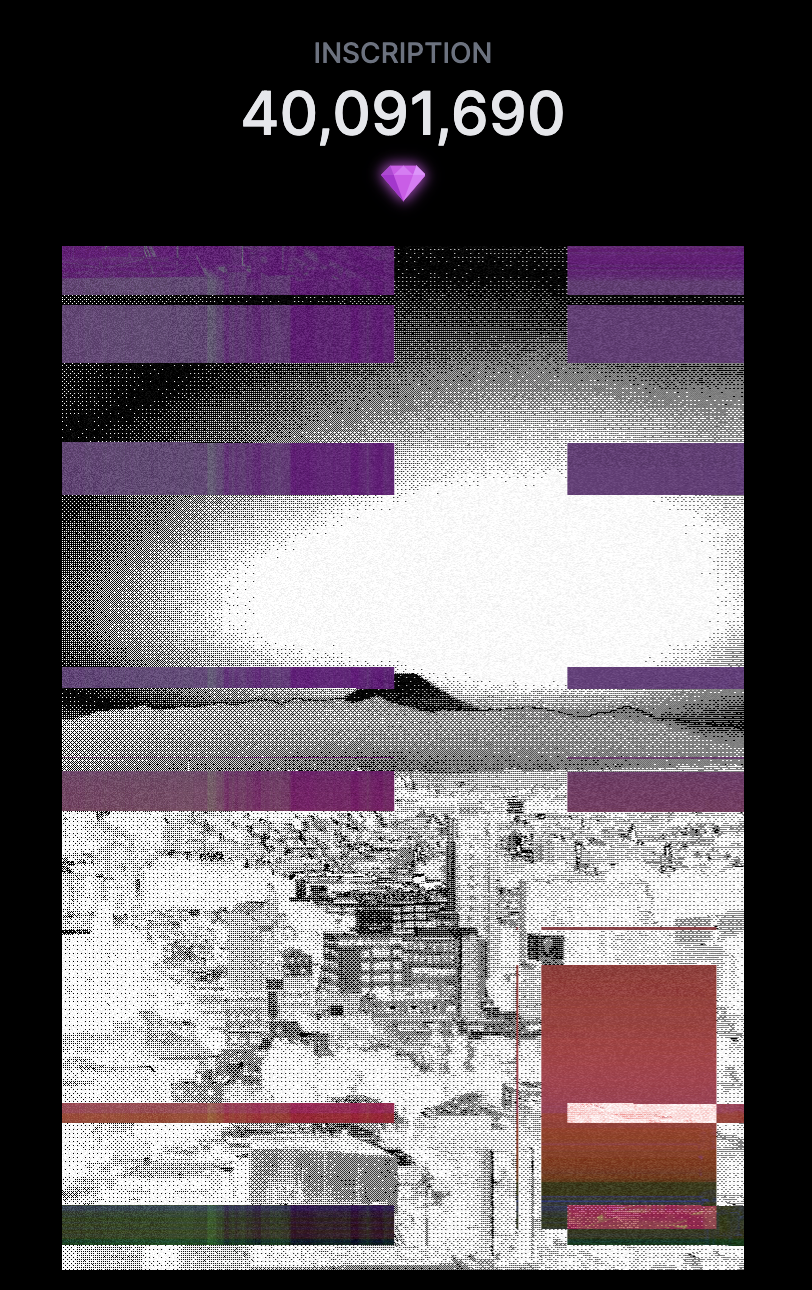I am Mag, a street photographer/Artist. Here is a brief profile.
Street photographer & artist searching for beauty hidden in everyday life, started his career in December 2021. Based on the technique of street snapshots, he takes photographs with the theme of moments where reality and fiction are ambiguously intermingled and where there is a blank space for the imagination. He is also challenging unconventional photographic expressions such as collaborations, secondary works, and abstract expressions based on photography.
I am pleased to announce my second Ordinals piece for Gamma Prints, "Deviation". The work will be released in two forms: a Dutch auction of the original 1/1 work and edition sales on Prints.
Outline of the work

It is an on-chain art that attempts to deviate from the concepts of photography by glitching a pure photo that has been persisted on Ordinals. The base photo is Inscription 34826878: "Mount Fuji from Tokyo". WEBGL and p5js code are implemented for the random continuous glitch, including bayer, color inversion, data-bending, block noise, and distortion. The original work was inscribed in Uncommon Sats, and the seed for the random glitch process is also based on Uncommon Sats Number. The structure of the code's constant glitching of the photo on the on-chain symbolizes the robustness of Ordinals' on-chain digital artifact, and the culture of continually evolving and deviating from existing concepts.
Inspiration for creating this work
I have always been interested in generative art using creative coding and wanted to use it myself to express myself.
When I was thinking about how to incorporate generative art into my work, I came across the concept of glitch art, and after seeing that there are artists such as Solemn and Sir Gadfly at Gamma Partner Artists who have created impressive glitch art, I decided to pursue the concept of glitch art using creative coding. I wanted to create a concept of glitch art using creative coding methods.
About the Concept
In conceptualizing glitch art, I began by researching glitch art, and here is a definition of glitch art from Wikipedia.
Glitch art is the practice of using digital or analog errors for aesthetic purposes by either corrupting digital data or physically manipulating electronic devices.
Examples of early glitch art include "Digital TV Dinner (1978)" by Jamie Fenton and Raul Zaritsky. The work includes elements such as image distortion, electronic sounds, and noise.
Originally an art form created by glitches in analog video games and videos, glitch art now seems to refer to the act of exploiting digital or analog errors for aesthetic purposes, either by corrupting digital data or by physically manipulating electronic devices.
In my research, I became interested in the free culture and ideology of glitch art, which has no sole significance, but each explores accidental visual novelty through system malfunction and destruction, and through these explorations, rethinks the way we deal with technology itself.
This led me to the concept of my work, to attempt to deviate from and rethink the concept of photography through glitching.
Production Process
When I thought about the expression using glitch art, it naturally came to me that I wanted the base to be a pure photograph inscribed in Ordinals, which is "Mount Fuji from Tokyo" released by Gamma Prints.

In the previous projects "Ordinal Tokyo Fragments" and "Recursive Tokyo Vintage 78," the photos were pre-processed off-chain before inscribing, so this time I wanted to take the approach of glitching the photos on-chain.
In researching how to glitch photo image data in coding, I came across WEBGL (Web Graphic Library) shaders.
WEBGL shaders are programs that perform processing on graphical data in the browser. They use GPUs instead of CPUs for processing, and can apply parallel processing to each pixel in an image.

I thought that the use of WEBGL shaders would be a good match for the expression I wanted to work on this time, as it allows for high-speed processing of even large image data. It was also attractive to me that many people were working on glitch processing with shaders, and I could get various inspirations as I worked on the project.
As an overview of the mechanism, p5.js is used to load the base photos, and the photo data on Ordinals inspiration is called up to the browser using Recursive Inscription. Then, glitching is applied to the called image data using WEBGL shaders.
Various types of glitches such as bayering, color inversion, databending, block noise, white noise, distortion, etc. are applied as randomly as possible. The complex random processing attempts to deviate from the concept of photography by creating visual coincidences.

Both the image data of the photo and the code that applies the glitching are persisted on-chain. The seed for the random glitching process is also based on the Number of Uncommon Sats, indicating that the work is derived from a unique Rare Sats.

I believe that the structure of the code's constant glitching of photos on the on-chain symbolizes the robustness of Ordinals' on-chain digital artifacts and the idea of deviating from existing concepts and continuing to evolve.
About List
Dutch Auction of Original 1/1 Works
-
Date: 11/20(Mon) at 21:00 (JST) / 7:00 (ET) ~
-
Price: Start 0.15 btc, End 0.01 btc
-
Duration: 2 Days
-
Link: https://gamma.io/inscription/8beb7313817da025c4a9f1ba4642d288538c5d1e87e898dbe8cfaa7d03171c8ei0
-
This is an on-chain auction where the time is determined by blockheight, so there will be some back and forth time
About Prints Sale
-
Date: 11/20(Mon) at 21:00 (JST) / 7:00 (ET) ~
-
Price: 40000 Sats + gas fee
-
Print Number: 100
-
Link: https://gamma.io/prints/8beb7313817da025c4a9f1ba4642d288538c5d1e87e898dbe8cfaa7d03171c8ei0
Conclusion
It was very challenging to produce a new genre of work, but at the same time it was an exciting experience.
I am looking forward to continuing to produce and explore future works of art and expression. Thank you for your continued support!
Thank you for reading to the end! If you think this NOTE is good, I would appreciate it if you could spread the word by RT or liking it if you like! Please feel free to contact me again with any questions or concerns!